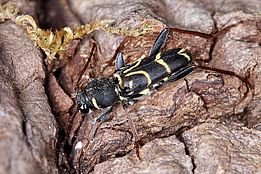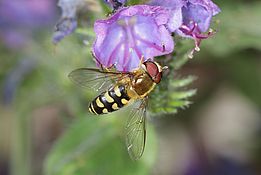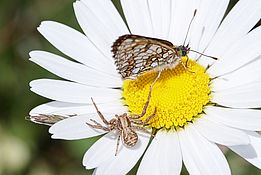Long-term dynamics of the arthropod fauna after windthrows
Marco Moretti
Martin Obrist
Doris Schneider
Martin Gossner
Martin Moritzi
1991 - 2021
Background
After the two large winter gales Vivian (1990) and Lothar (1999) at the end of the last century significant amounts of fallen timber were left unharvested on windthrow areas in Switzerland, both for economic and ecological reasons. WSL established long-term research plots on several windthrow areas in mountain forests and in the Central Plateau. On some subplots the fallen timber was traditionally harvested and on others the dead trees were left untouched undergoing their natural decay.
Since 1991 we have been monitoring on these plots the long-term development and composition of the invertebrate fauna, in particular insects, spiders and woodlice, at regular intervals. We also compare this fauna with that in adjacent forests untouched by the storms. This allows insights into the processes and velocity of the succession of taxonomic and functional animal groups at different elevations along the trajectory of open windthrows to new closed forests (resilience). In addition, the effects of timber salvation can be assessed with respect to both short-term phytosanitary issues and long-term ecological/conservational aspects.
We also compare these processes in windthrows with analogous results from our forest fire research.
Questions
· How long does the fallen timber remain suitable for spruce bark beetle breeding?
· Are there differences between the fauna on cleared and uncleared windthrows?
· How fast does the insect fauna in windthrows approach that in intact forests (resilience)?
· Does the succession dynamics of invertebrates differ in mountain and lowland forests?
· How long does uncleared timber stimulate saproxylic insect biodiversity?
· Which state of deadwood decay supports most endangered insect species?
Methods
During the entire growth seasons in the monitoring years several types of insect traps (window traps, yellow pans, combi-traps, pitfall traps) are operated. They are weekly emptied and their catches sorted to taxonomic units and eventually identified to species level by internal and external specialists.
The monitoring years are:
Vivian (storm 1990): 1991, 1992, 1993, 1994, 1996, 2000, 2009 (20 years)
Lothar (storm 1999): 2000, 2001, 2004, 2010, 2019 (20 years)
Significance
The unique long-term data of insect communities from mountain spruce forests and mixed forests from lowlands are highly relevant for forest management, forest biodiversity conservation and ecological research. They will become even more important in the light of disturbances, such as windstorm and fire, likely becoming more frequent and/or severe in the future.
Selected publications
Scientific papers
· Thorn, S.; Bässler, C.; Brandl, R.; Burton, P.J.; Cahall, R.; Campbell, J.L.; Castro, J.; Choi, C.; Cobb, T.; Donato, D.C.; Durska, E.; Fontaine, J.B.; Gauthier, S.; Hebert, C.; Hothorn, T.; Hutto, R.L.; Lee, E.; Leverkus, A.B.; Lindenmayer, D.B.; ... Müller, J., 2018: Impacts of salvage logging on biodiversity: a meta-analysis. Journal of Applied Ecology, 55: 279-289.
· Wermelinger, B.; Moretti, M.; Duelli, P.; Lachat, T.; Pezzatti, G.B.; Obrist, M.K., 2017: Impact of windthrow and salvage-logging on taxonomic and functional diversity of forest arthropods. Forest Ecology and Management, 391: 9-18.
· Wermelinger B., Obrist M.K., Baur H., Jakoby O., Duelli, P., 2013: Synchronous rise and fall of bark beetle and parasitoid populations in windthrow areas. Agric. For. Entomol. 15: 301-309.
· Wermelinger, B., Duelli, P., Obrist, M.K., 2002: Dynamics of saproxylic beetles (Coleoptera) in windthrow areas in alpine spruce forests. For. Snow Landsc. Res. 77: 133-148.
· Duelli, P., Obrist, M.K., Wermelinger, B., 2002: Windthrow-induced changes in faunistic biodiversity in alpine spruce forests. For. Snow Landsc. Res. 77: 117-131.
· Wermelinger, B., Obrist, M.K., Duelli, P., Forster, B., 1999: Development of the bark beetle (Scolytidae) fauna in windthrow areas in Switzerland. Mitt. Schweiz. Entomol. Ges. 72: 209-220.
Outreach articles (German)
· Schönenberger, W., Angst, C., Bründl, M., Dobbertin, M., Duelli, P., Egli, S., Frey, W., Gerber, W., Kupferschmid Albisetti, A., Lüscher, P., Senn, J., Wermelinger, B., Wohlgemuth, T., 2003: Vivians Erbe – Waldentwicklung nach Windwurf im Gebirge. Merkbl. Prax. WSL 36, 12 S. (dt., frz., it.)
· Wermelinger, B., Duelli, P., Obrist, M., Odermatt, O., Seifert, M., 1995: Die Entwicklung der Fauna auf Windwurfflächen mit und ohne Holzräumung. Schweiz. Z. Forstwes. 146: 913-928.
Publications
- Stockdale, Ch.A.; Bozzini, C.; Macdonald, S.E.; Higgs, E., 2015: “Extracting ecological information from oblique angle terrestrial landscape photographs: Performance evaluation of the WSL Monoplotting Tool” Applied Geography 63 (2015), pp. 315-325, September 2015
- Conedera, M.; Bozzini, C.; Krebs, P.; Scapozza, C., 2015: La monofotogrammetria applicata al settore forestale: nuovo software sviluppato dal WSL. Sherwood 21, 210: 27-30.
- Scapozza, C.; Lambiel, C.; Bozzini, C.; Mari, S.; Conedera, M., 2014: Assessing the rock glacier kinematics on three different timescales: A case study from the southern Swiss Alps. Earth Surf. Process. Landf. 39: 2056-2069.
- Bozzini, C.; Conedera, M.; Krebs, P., 2013: A new tool for facilitating the retrieval and recording of the place name cultural heritage. In: Grussenmeyer, P. (ed.): XXIV International CIPA Symposium, Strasbourg, France, September 02 - 06, 2013, ISPRS Archives – Volume XL-5/W2, 2013, pp. 115-118
- Conedera, M.; Bozzini, C.; Scapozza, C.; Rè, L.; Ryter, U.; Krebs, P., 2013: Anwendungspotenzial des WSL-Monoplotting-Tools im Naturgefahrenmanagement. Schweiz Z Forstwes 164 (2013) 7: 173–180.
- Fischer, R.; Bozzini, C., 2013: Fotos wie Karten lesen. Horizonte – Das Schweizer Forschungsmagazin Nr. 96, März 2013
- Fischer, R.; Bozzini, C., 2013: Lire les photos comme des cartes. Horizons - Le magazine suisse de la recherche scientifique no 96, Mars 2013
- Bozzini, C.; ; Krebs, P.; Conedera, M., 2012: Neues Tool zur Georeferenzierung von terrestrischen Schrägbildern. Geosciences Actuel - Forschung und Praxis | Recherches et Applications. 27-28.
- Scapozza, C.; Bozzini, C., 2012: Quando le vecchie foto raccontano: l’alluvione del 1927 a Olivone. Voce di Blenio: 8-9.
- Bozzini, C.; Conedera, M.; Krebs, P., 2012: A New Monoplotting Tool to Extract Georeferenced Vector Data and Orthorectified Raster Data from Oblique Non-Metric Photographs. International Journal of Heritage in the Digital Era 1, 3: 500-518.
- Wiesmann, S.; Steiner, L.; Pozzi, M.; Bozzini, C.; Hurni, L., 2012: Reconstructing Historic Glacier States Based on Terrestrial Oblique Photograph.AutoCarto International Symposium on Automated Cartography, Columbus, Ohio, USA, 16-18 September 2012
- Bozzini, C.; ; Krebs, P.; Conedera, M., 2012: Ein neues Tool zur Georeferenzierung und Orthorektifizierung von terrestrischen Schrägbildern. forum.landschaft forum.paysage INFOLETTER 2: 2-3.
- Bozzini, C.; Conedera, M.; Krebs, P., 2012: Ein neues Tool zur Georeferenzierung und Orthorektifizierung von terrestrischen Schrägbildern. Geomatik Schweiz 4: 159-161.
- Bozzini, C.; Conedera, M.; Krebs, P., 2011: Un nouvel outil pour le géoréférencement et l'interprétation de photographies terrestres obliques. Bulletin: e-geo.ch 27, 4: 16-17.
- Bozzini, C.; Conedera, M.; Krebs, P., 2011: Ein neues Tool zur Georeferenzierung und Interpretation von terrestrischen Schrägbildern. Newsletter e-geo.ch 27, 4: 16-17.
- Bozzini, C.; Conedera, M.; Krebs P., 2011: La monofotogrammetria: L'evoluzione di uno strumento per il monitoraggio, la pianificazione e la storia del paesaggio. Archi 2: 45-51.
- Bozzini, C.; Conedera, M.; Krebs, P., 2011: A new tool for obtaining cartographic georeferenced data from single oblique photos. In: Pavelka, K. (ed) XXIIIrd International CIPA Symposium Prague, Czech Republic, September 12-16, 2011. Prague, CIPA. 6 p.


